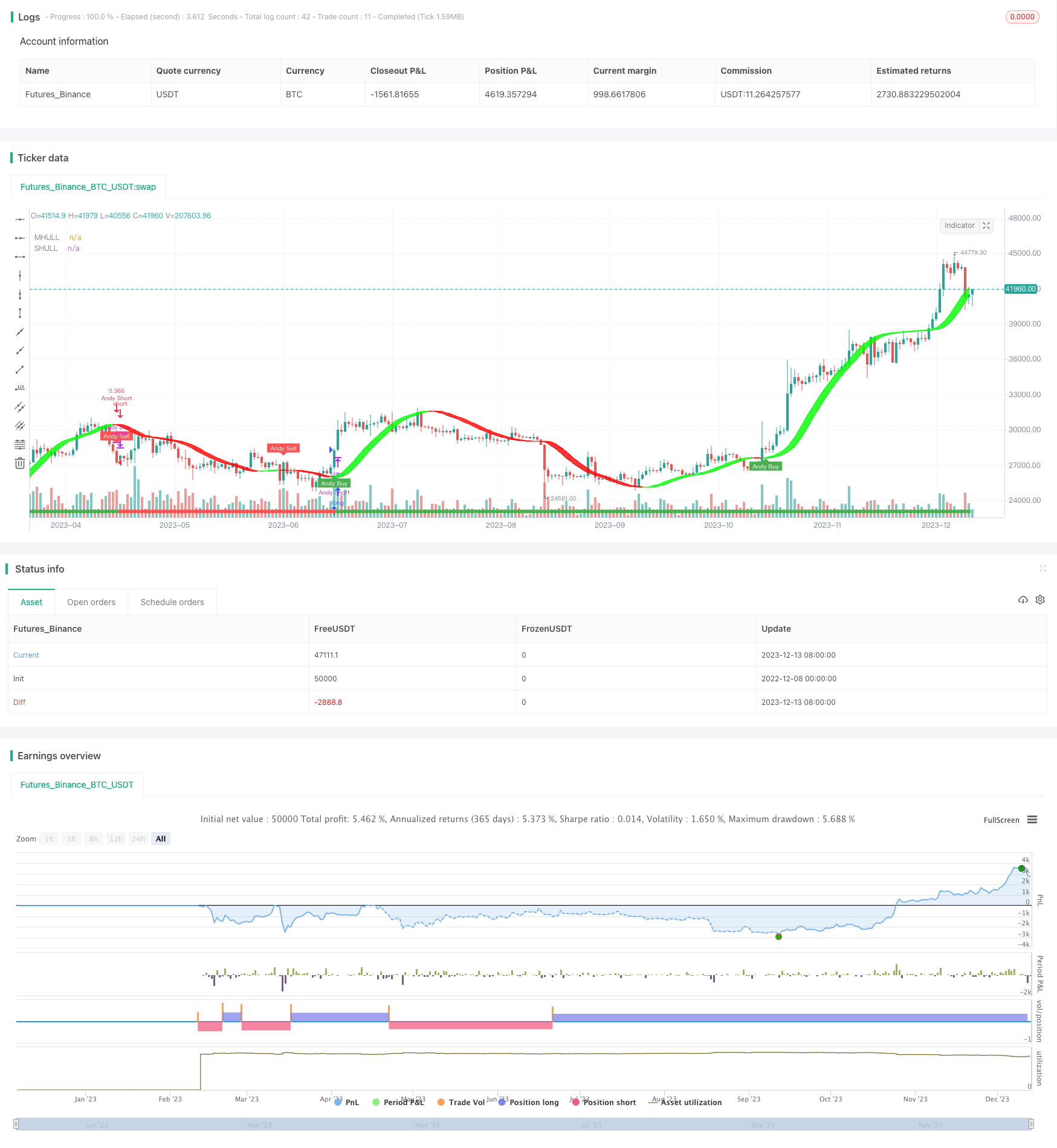
概述
Dynamic Momentum Oscillator Trading Strategy(DMO策略)是一个基于动量震荡指标的15分钟短线交易策略。该策略结合多种技术指标实现高精确度的交易信号,可有效辅助新手交易者在短时间内进行买卖决策,控制风险,提高盈利概率。
策略原理
该策略首先使用Doinchian通道判断市场主要趋势方向。当价格突破该通道上沿时为看涨信号,若突破下沿则为看跌信号。其次,策略采用3种Hull移动平均线变体中的一种,结合自适应ATR通道实现更精确的趋势判断。当快线上穿中线时为买入信号,下穿中线则为卖出信号。最后,结合半整平均指标的辅助,过滤掉部分假信号,提高信号的可靠性。在获悉较为可靠的交易信号后,策略即进入对应的多空头仓位。
优势分析
DMO策略最大的优势在于多种指标的有机结合,不同指标可相互验证,从而过滤假信号,使每次交易信号更加精确可靠。此外,Doinchian通道判断主趋势的方式简单直接,半整平均线过滤信号的手段也较为常规,整体而言易于理解,新手上手难度不大。相比单一指标,DMO可在同等交易次数下获得更高胜率和盈利率。
风险分析
尽管DMO策略较为稳定可靠,但任何量化交易策略都难免存在一定风险。具体来说,快线与中线产生死叉时,如果没有其他指标验证,依然有可能是假信号。此外,像所有短线策略一样,DMO也面临一定的过度交易风险。如果遇到市场突发事件导致指标失效,停损幅度设定不当也会造成较大损失。为降低风险,建议适当调整中长期指标参数,并与更高时间周期指标进行组合验证,同时加大停损距离,严格控制单笔损失。
优化方向
DMO策略可从以下几个维度进行优化:第一,调整Hull MA的参数,优化移动平均线的长度,平滑效果与灵敏度之间的平衡;第二,改进Doinchian通道判断逻辑,如调整通道参数,或增加附加条件限制入场;第三,尝试其他指标代替半整平均,如布林带、KDJ等,提高辅助过滤效果;第四,根据不同品种特点指定合适的交易区间,如改为5分钟或30分钟策略。这些优化举措有助于根据市场环境和品种特征量身定制DMO策略,提升策略稳定性。
总结
DMO是一套多指标优化组合的短线策略。它融合Doinchian通道、Hull MA以及半整平均线,有效判断市场趋势,产生精确的交易信号。策略手段相对简单直观,操作难度不大,可作为新手的入门策略。与单一指标相比,DMO可产生更高的交易胜率和盈利率。通过调参数、改进组合及指定交易区间等措施,DMO策略可望获得更长期更稳定的优异表现。
/*backtest
start: 2022-12-08 00:00:00
end: 2023-12-14 00:00:00
period: 1d
basePeriod: 1h
exchanges: [{"eid":"Futures_Binance","currency":"BTC_USDT"}]
*/
// This source code is subject to the terms of the Mozilla Public License 2.0 at https://mozilla.org/MPL/2.0/
// © kgynofomo
//@version=5
strategy(title="[Salavi] | Andy Super Pro Strategy [BTC|M15]",overlay = true, pyramiding = 1,initial_capital = 10000, default_qty_type = strategy.cash,default_qty_value = 10000)
//Doinchian Trend Ribbon
dlen = input.int(defval=30, minval=10)
dchannel(len) =>
float hh = ta.highest(len)
float ll = ta.lowest(len)
int trend = 0
trend := close > hh[1] ? 1 : close < ll[1] ? -1 : nz(trend[1])
trend
dchannelalt(len, maintrend) =>
float hh = ta.highest(len)
float ll = ta.lowest(len)
int trend = 0
trend := close > hh[1] ? 1 : close < ll[1] ? -1 : nz(trend[1])
maintrend == 1 ? trend == 1 ? #00FF00ff : #00FF009f : maintrend == -1 ? trend == -1 ? #FF0000ff : #FF00009f : na
maintrend = dchannel(dlen)
donchian_bull = maintrend==1
donchian_bear = maintrend==-1
//Hulls
src = input(hlc3, title='Source')
modeSwitch = input.string('Hma', title='Hull Variation', options=['Hma', 'Thma', 'Ehma'])
length = input(55, title='Length')
lengthMult = input(1.0, title='Length multiplier ')
useHtf = false
htf = '240'
switchColor = true
candleCol = false
visualSwitch = true
thicknesSwitch = 1
transpSwitch = 40
//FUNCTIONS
//HMA
HMA(_src, _length) =>
ta.wma(2 * ta.wma(_src, _length / 2) - ta.wma(_src, _length), math.round(math.sqrt(_length)))
//EHMA
EHMA(_src, _length) =>
ta.ema(2 * ta.ema(_src, _length / 2) - ta.ema(_src, _length), math.round(math.sqrt(_length)))
//THMA
THMA(_src, _length) =>
ta.wma(ta.wma(_src, _length / 3) * 3 - ta.wma(_src, _length / 2) - ta.wma(_src, _length), _length)
//SWITCH
Mode(modeSwitch, src, len) =>
modeSwitch == 'Hma' ? HMA(src, len) : modeSwitch == 'Ehma' ? EHMA(src, len) : modeSwitch == 'Thma' ? THMA(src, len / 2) : na
//OUT
_hull = Mode(modeSwitch, src, int(length * lengthMult))
HULL = useHtf ? request.security(syminfo.ticker, htf, _hull) : _hull
MHULL = HULL[0]
SHULL = HULL[2]
//COLOR
hullColor = switchColor ? HULL > HULL[2] ? #00ff00 : #ff0000 : #ff9800
hull_bull = HULL > HULL[2]
bull_start = hull_bull and hull_bull[1]==false
hull_bear = HULL < HULL[2]
bear_start = hull_bear and hull_bear[1]==false
barcolor(color=candleCol ? switchColor ? hullColor : na : na)
//halftrend
amplitude = input(title='Amplitude', defval=2)
channelDeviation = input(title='Channel Deviation', defval=2)
// showArrows = input(title='Show Arrows', defval=true)
// showChannels = input(title='Show Channels', defval=true)
var int trend = 0
var int nextTrend = 0
var float maxLowPrice = nz(low[1], low)
var float minHighPrice = nz(high[1], high)
var float up = 0.0
var float down = 0.0
float atrHigh = 0.0
float atrLow = 0.0
float arrowUp = na
float arrowDown = na
atr2 = ta.atr(100) / 2
dev = channelDeviation * atr2
highPrice = high[math.abs(ta.highestbars(amplitude))]
lowPrice = low[math.abs(ta.lowestbars(amplitude))]
highma = ta.sma(high, amplitude)
lowma = ta.sma(low, amplitude)
if nextTrend == 1
maxLowPrice := math.max(lowPrice, maxLowPrice)
if highma < maxLowPrice and close < nz(low[1], low)
trend := 1
nextTrend := 0
minHighPrice := highPrice
minHighPrice
else
minHighPrice := math.min(highPrice, minHighPrice)
if lowma > minHighPrice and close > nz(high[1], high)
trend := 0
nextTrend := 1
maxLowPrice := lowPrice
maxLowPrice
if trend == 0
if not na(trend[1]) and trend[1] != 0
up := na(down[1]) ? down : down[1]
arrowUp := up - atr2
arrowUp
else
up := na(up[1]) ? maxLowPrice : math.max(maxLowPrice, up[1])
up
atrHigh := up + dev
atrLow := up - dev
atrLow
else
if not na(trend[1]) and trend[1] != 1
down := na(up[1]) ? up : up[1]
arrowDown := down + atr2
arrowDown
else
down := na(down[1]) ? minHighPrice : math.min(minHighPrice, down[1])
down
atrHigh := down + dev
atrLow := down - dev
atrLow
ht = trend == 0 ? up : down
var color buyColor = color.blue
var color sellColor = color.red
htColor = trend == 0 ? buyColor : sellColor
// htPlot = plot(ht, title='HalfTrend', linewidth=2, color=htColor)
// atrHighPlot = plot(showChannels ? atrHigh : na, title='ATR High', style=plot.style_circles, color=color.new(sellColor, 0))
// atrLowPlot = plot(showChannels ? atrLow : na, title='ATR Low', style=plot.style_circles, color=color.new(buyColor, 0))
// fill(htPlot, atrHighPlot, title='ATR High Ribbon', color=color.new(sellColor, 90))
// fill(htPlot, atrLowPlot, title='ATR Low Ribbon', color=color.new(buyColor, 90))
HalfTrend_buySignal = not na(arrowUp) and trend == 0 and trend[1] == 1
HalfTrend_sellSignal = not na(arrowDown) and trend == 1 and trend[1] == 0
// plotshape(showArrows and buySignal ? atrLow : na, title='Arrow Up', style=shape.triangleup, location=location.absolute, size=size.tiny, color=color.new(buyColor, 0))
// plotshape(showArrows and sellSignal ? atrHigh : na, title='Arrow Down', style=shape.triangledown, location=location.absolute, size=size.tiny, color=color.new(sellColor, 0))
//ema
filter_ema = ta.ema(close,200)
ema_bull = close>filter_ema
ema_bear = close<filter_ema
atr_length = input.int(7)
atr = ta.atr(atr_length)
atr_rsi_length = input.int(50)
atr_rsi = ta.rsi(atr,atr_rsi_length)
atr_valid = atr_rsi>50
longCondition = bull_start and atr_valid
shortCondition = bear_start and atr_valid
Exit_long_condition = shortCondition
Exit_short_condition = longCondition
if longCondition
strategy.entry("Andy Buy",strategy.long, limit=close,comment="Andy Buy Here")
if Exit_long_condition
strategy.close("Andy Buy",comment="Andy Buy Out")
// strategy.entry("Andy fandan Short",strategy.short, limit=close,comment="Andy 翻單 short Here")
// strategy.close("Andy fandan Buy",comment="Andy short Out")
if shortCondition
strategy.entry("Andy Short",strategy.short, limit=close,comment="Andy short Here")
// strategy.exit("STR","Long",stop=longstoploss)
if Exit_short_condition
strategy.close("Andy Short",comment="Andy short Out")
// strategy.entry("Andy fandan Buy",strategy.long, limit=close,comment="Andy 翻單 Buy Here")
// strategy.close("Andy fandan Short",comment="Andy Buy Out")
inLongTrade = strategy.position_size > 0
inLongTradecolor = #58D68D
notInTrade = strategy.position_size == 0
inShortTrade = strategy.position_size < 0
// bgcolor(color = inLongTrade?color.rgb(76, 175, 79, 70):inShortTrade?color.rgb(255, 82, 82, 70):na)
plotshape(close!=0,location = location.bottom,color = inLongTrade?color.green:inShortTrade?color.red:na)
plotshape(longCondition, title='Buy', text='Andy Buy', style=shape.labelup, location=location.belowbar, color=color.new(color.green, 0), textcolor=color.new(color.white, 0), size=size.tiny)
plotshape(shortCondition, title='Sell', text='Andy Sell', style=shape.labeldown, location=location.abovebar, color=color.new(color.red, 0), textcolor=color.new(color.white, 0), size=size.tiny)
Fi1 = plot(MHULL, title='MHULL', color=hullColor, linewidth=thicknesSwitch, transp=50)
Fi2 = plot(SHULL, title='SHULL', color=hullColor, linewidth=thicknesSwitch, transp=50)
fill(Fi1, Fi2, title='Band Filler', color=hullColor, transp=transpSwitch)